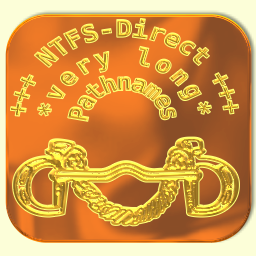GPP. - Get Path Part |
Previous Top Next (GFT.) |
MiniRobotLanguage (MRL)
GPP. Command
Get Path Part

Intention
GPP. evaluates a file path string based on specified keywords and modifiers. It returns requested parts of the file name and/or path, optionally controlling formatting like casing and trailing slashes.
This command replaces the older GFT. command with a more readable and flexible syntax.
The functionality is strictly one of parsing alone. No attempt is made to find the file on disk.
This command is similar to GFT. yet it has a different syntax and options.
Syntax
GPP.PartTypes|$$InputPath[|$$OutputVar1[|$$OutputVar...]]
Parameter Explanation
PartTypes: A comma-separated string containing keywords that specify which parts to extract and optional modifiers. Keywords and modifiers are case-insensitive.
Modifiers:
·mcase: Applies MCase (Title Case) formatting to the $$InputPath *before* extracting parts. Affects the case of the results.
·trimtrail: Removes any trailing backslash (\) or space from $$InputPath *before* processing (e.g., "C:\folder \ " becomes "C:\folder").
·concat: Concatenates all requested part keyword results into a single string. This combined result is placed in $$OutputVar1 (if provided) or on the Top-Of-Stack (TOS) if no output variables are given.
·fixlongpath: Removes the `\\?\` prefix from $$InputPath if present *before* processing. Otherwise, `\\?\` might be treated as part of the root.
·forceslash: Ensures that the result of a path-like keyword (see Keywords list) ends with a trailing backslash (\). Adds one if missing. Cannot be used with noslash.
·noslash: Ensures that the result of a path-like keyword (see Keywords list) does *not* end with a trailing backslash (\). Removes any trailing backslashes. Cannot be used with forceslash.
Part Keywords: (Using c:\Folder\Sub\Filename.pdf as primary example)
·root: Root drive or share (e.g., "c:", "\\server\share\") -> "c:" [Path-like¹]
·fileext: Filename with extension (After Last Backslash - ALB) -> "Filename.pdf"
·pathonly: Full path without filename, guaranteed no trailing '\' -> "c:\Folder\Sub" [Path-like¹]
·ext: File extension *without* the leading dot -> "pdf"
·nameonly: Filename *without* path or extension -> "Filename"
·noroots: Path and filename *without* the root drive -> "Folder\Sub\Filename.pdf" [Path-like¹]
·pathnoext: Full path and filename *without* the extension -> "c:\Folder\Sub\Filename" [Path-like¹]
·fullpath: Path portion *including* the trailing backslash '\' (if applicable) -> "c:\Folder\Sub\" [Path-like¹]
·extdot: Extension *including* the leading dot -> ".pdf"
·nameext: Filename and extension, *without* the path -> "Filename.pdf"
·parent: The path of the parent directory, typically ending with '\' -> "c:\Folder\Sub\" (from example), "c:\" (from "c:\file.txt") [Path-like¹]
·driveletter: The drive letter *only*, without colon or slash -> "c" (Returns empty string for UNC paths or paths without drive letters)
¹Path-like keywords are affected by the forceslash and noslash modifiers.
$$InputPath: The file path string (or a variable containing it, e.g., $$ABC) which shall be split into parts. Must be given.
$$OutputVar1, $$OutputVar2 ... $$Xyz: (optional) Variables (format $$ followed by exactly three characters) to receive the extracted parts.
·If the concat modifier is NOT used: The result of the first part keyword requested in PartTypes goes into $$OutputVar1, the second into $$OutputVar2, and so on. If fewer output variables are provided than parts requested, the remaining results are placed on the Top-Of-Stack (TOS), with the last requested part being topmost.
·If the concat modifier IS used: Only $$OutputVar1 is used (if provided) to store the single concatenated string. If no output variable is specified, the concatenated result goes to TOS.
Comprehensive Example
The following example demonstrates many features of GPP.
VAR.$$FIL=C:\Program Files (x86)\my app\launcher.exe
VAR.$$FLD=D:\Data\Images\
VAR.$$LNP=\\?\UNC\Server\Share\document.txt
VAR.$$UNC=\\Server\Share\script.mrl
PRT.Input File: $$FIL
GPP.root,pathonly,nameonly,ext,driveletter|$$FIL|$$ROT|$$POF|$$NMO|$$EXT|$$DLT
PRT.Root=$$ROT
PRT.Path Only=$$POF
PRT.Name Only=$$NMO
PRT.Extension=$$EXT
PRT.Drive Letter=$$DLT
PRT.--------------------------------
GPP.parent|$$FIL|$$PAR
PRT.Parent=$$PAR
GPP.parent|C:\TEMP|$$PRT
PRT.Parent of C:\TEMP=$$PRT
PRT.--------------------------------
PRT.Input Folder: $$FLD
GPP.fullpath,noslash|$$FLD|$$PNS
PRT.Full Path No Slash=$$PNS
GPP.pathonly,forceslash|$$FLD|$$PFS
PRT.Path Only Force Slash=$$PFS
PRT.--------------------------------
PRT.Using mcase modifier on $$FIL
GPP.fullpath,nameext,mcase|$$FIL
POP.$$NEX
POP.$$FUP
PRT.MCase Full Path=$$FUP
PRT.MCase Name+Ext=$$NEX
PRT.--------------------------------
PRT.Using concat modifier
GPP.pathnoext,extdot,concat|$$FIL|$$CN1
PRT.Concatenated Path+Name+DotExt=$$CN1
PRT.--------------------------------
PRT.Using fixlongpath modifier
PRT.Input Long Path: $$LNP
GPP.fixlongpath,root|$$LNP|$$FXR
PRT.Fixed Root=$$FXR
PRT.--------------------------------
PRT.Using trimtrail modifier
VAR.$$TT1=C:\Test\Folder\
GPP.trimtrail,pathonly|$$TT1|$$TRP
PRT.Trimmed Trail Path Only=$$TRP
PRT.--------------------------------
PRT.UNC Path Example
PRT.Input UNC: $$UNC
GPP.root,nameonly,extdot|$$UNC|$$URT|$$UNM|$$UEX
PRT.UNC Root=$$URT
PRT.UNC Name Only=$$UNM
PRT.UNC Ext Dot=$$UEX
GPP.driveletter|$$UNC|$$UDL
PRT.UNC Drive Letter=$$UDL
PRT.--------------------------------
MBX.GPP Demo Complete!
END.
Remarks
·Keywords and Modifiers in PartTypes are case-insensitive.
·This command supports NTFS-direct.
·The order of part keywords in PartTypes determines the output order when not using concat and when sending results to output variables or the stack (TOS).
·The forceslash and noslash modifiers only affect path-like results (see keyword list). They are mutually exclusive.
·The parent keyword typically returns the parent path including a trailing slash (unless it's the root drive like "C:\" or modified by noslash). For a path without a directory component (e.g., "file.txt"), it returns an empty string.
Limitations:
·The maximum number of distinct output parts (when not using concat) is limited by the internal parameter splitting mechanism (typically around 18 separate output variables can be specified).
See also:
• 1.5.2 Working with Text-Strings
• GFT. - Get-File-Token (Older command)
• ALB - After last Backslash (Concept)
• BLB - Before last Backslash (Concept)